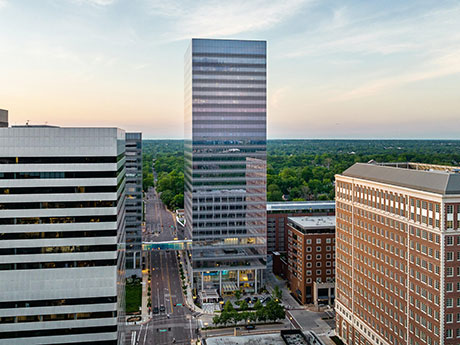By Nick Fiquette, Sansone Group
Lingering effects of COVID-19
In the aftermath of the global pandemic, the St. Louis real estate market finds itself at a crossroads, continuing to see the persistent impacts of COVID-19. Corporate strategies are evolving as companies evaluate their real estate footprints to accommodate the changing work environment and desires of employees.
As lease expirations loom, businesses are engaged in a delicate dance of evaluating their physical space needs. The pendulum of work-from-home policies, initially adopted to streamline footprints, appears to be swinging back. Recently, Edward Jones listed a 227,000-square-foot Class A building that it owns on the market for lease and is planning on occupying it instead. This example could serve as a positive indicator for the future of the office market.

The market is transforming as companies look to accommodate employee demands, prioritizing safe, walkable areas and amenity-rich buildings. This shift is particularly evident in the struggle faced by commodity real estate, as businesses increasingly gravitate toward locations that contribute positively to the employee experience. As a result, investors are remaining cautious about purchasing office assets due to surging interest rates and uncertainties surrounding the future of the office market.
Corporate giants reevaluate real estate footprints
Major corporations in St. Louis, including Centene, Mercy and SSM Health, have become key players in reshaping the real estate landscape. Their decisions to reevaluate and consolidate footprints have far-reaching consequences, creating changes in available office space.
Centene, once the largest occupier of office space in the St. Louis area, has placed large blocks of space on the market. Centene’s adoption of remote work models has resulted in notable subleases being placed on the market, such as 317,000 square feet at Timberlake and 182,000 square feet at Corporate Hill IV (which has been subleased to SSM Health). Additionally, Centene vacated 100,000 square feet at Creve Couer Pointe in 2023.
Mercy’s decision to consolidate its administrative footprint from leased to owned space in Chesterfield will create significant opportunities for other users. With over 400,000 square feet of leased space along the 40 Corridor, which will be vacated by mid-2025, Corporate Plaza and Maryville Centre stand as enticing opportunities for large users to backfill Mercy’s former footprint.
Another major healthcare organization, SSM Health, is streamlining its operations from over 450,000 square feet across St. Louis County to a more efficient 182,000-square-foot, single-tenant building at Corporate Hill IV. This move is poised to impact the entire St. Louis metro area, with everyone bracing for the ripple effect of upcoming vacancies throughout the market.
Redefining workspace preferences
As companies reassess their footprints, a discernible trend emerges — “flight to quality” characterized by a preference for Class A, amenity-rich spaces. Owners of existing properties are adapting by investing in updated amenity centers to remain competitive in attracting and retaining tenants.
Buildings such as PNC Center, Pierre Laclede Center, Shaw Park Plaza and The Plaza in Clayton are at the forefront of this transformation. The landlords are implementing or planning updated amenity packages to compete with newer Class A properties.
In West County, Chesterfield Village has experienced increased leasing velocity based on investment in amenities since being acquired from Sachs Properties. The focus on quality and amenities becomes paramount as occupiers seek spaces that align with evolving workplace preferences.
Submarket dynamics: varied demand across St. Louis
Each submarket of St. Louis is seeing different demand needs. Clayton remains the most desirable in the St. Louis market with buildings that have enhanced amenities; however, this comes with a high price tag that tenants are willing to pay. This submarket boasts the highest rates in St. Louis, topping out over $45 per square foot, but has seen notable transactions such as: Emerson leasing 100,000 square feet, Polsinelli securing 70,000 square feet and Equifax taking 71,000 square feet.
While West County remains to see steady demand due to its advantages, including interstate access, free parking and median rental rates, the influx of large available spaces along the 40 Corridor raises concerns about increasing vacancy rates.
Meanwhile, the St. Louis central business district faces the unique challenge of backfilling large blocks of space with limited demand. Despite offering the lowest rates in St. Louis and ample options, concerns about crime, parking and earnings tax contribute to a trend of tenants fleeing for the county.
The office evolution
Contrary to doomsday predictions for the office market, the current scenario echoes the evolution of e-commerce in the face of declining brick-and-mortar retail. The office is not dead; instead, users are fine-tuning their footprints for efficiency across their organization.
The real estate market is experiencing a correction as users navigate the nuances of achieving maximum efficiency while meeting the demands of their employees. Quality, amenity-rich real estate in walkable areas with low crime rates continues to witness strong demand, while commodity real estate and less favorable locations face turbulence.
Overall, the vitality of the office remains. At the end of the day, quality real estate in good locations will continue to thrive through the ups and downs of the real estate cycle.
Nick Fiquette is a director of office services with Sansone Group. This article originally appeared in the January 2024 issue of Heartland Real Estate Business magazine.


